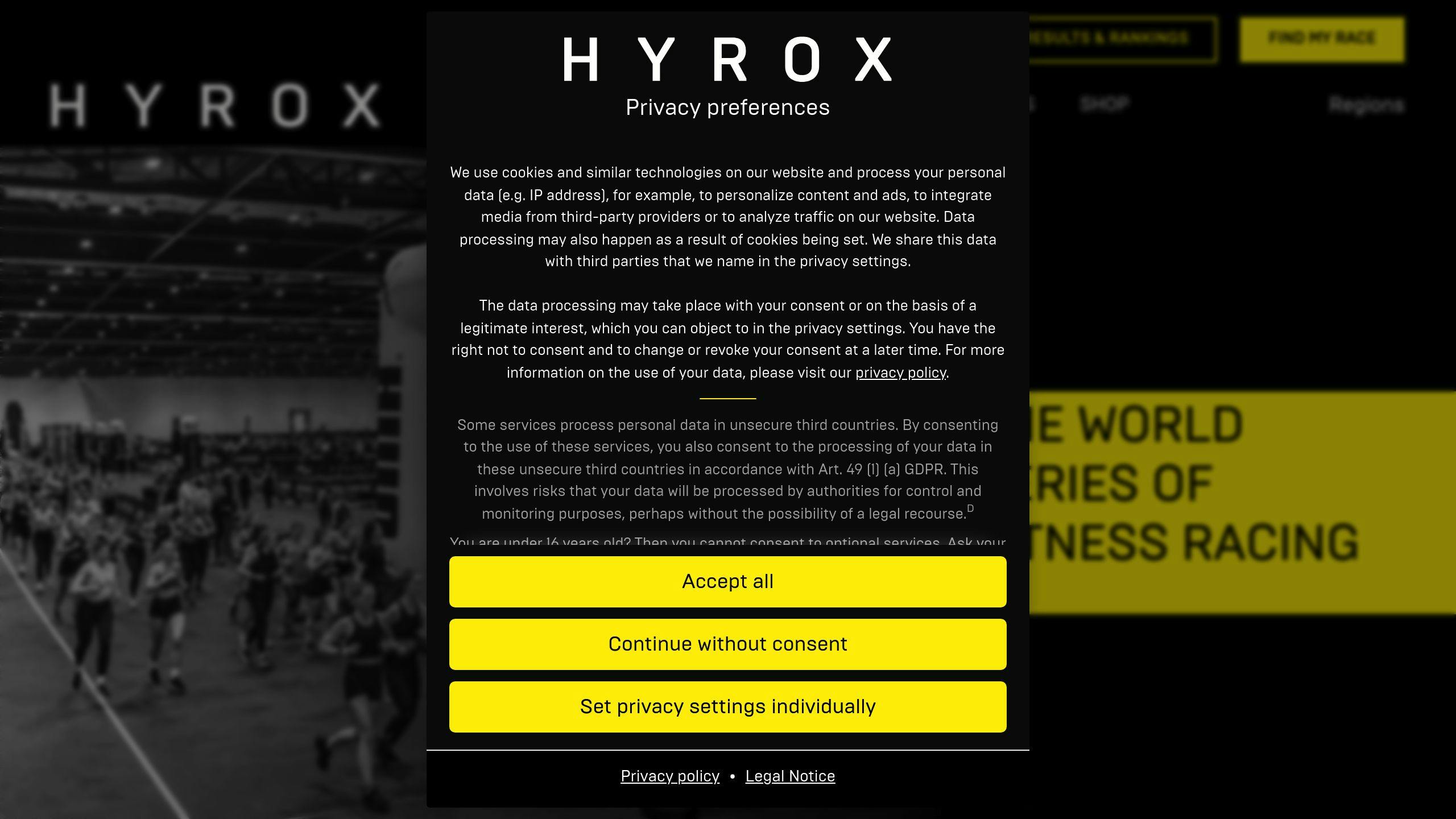A microcycle is a 7-10 day training plan that balances strength, endurance, and recovery to optimize performance in Hyrox competitions. Here’s what you need to know:
- Structure: 5-6 training days and 1-2 rest days per week.
- Focus Areas:
- Endurance (60%): Running intervals and aerobic work.
- Strength (40%): Heavy lifting, functional movements, and loaded carries.
- Recovery: Sleep, active recovery, and HRV monitoring.
- Periodization: Microcycles fit into larger mesocycles (3-6 weeks) and macrocycles (yearly plans) to progressively build fitness.
- Tapering: Reduce volume by 40-60% in the final 7-14 days before competition to peak effectively.
Weekly Example:
- Training Days: Alternate high-intensity strength and moderate-intensity endurance.
- Recovery: 1-2 full rest days with active recovery sessions.
Pro Tip: Track metrics like HRV and RPE to adjust training and prevent overtraining. A well-designed microcycle ensures steady progress and competition readiness.
How to Create a Training Plan for HYROX

Key Elements of a Microcycle
A well-planned Hyrox microcycle focuses on three main components that work together to improve performance while reducing the risk of overtraining. These elements are designed to complement each other, creating a balanced and effective training structure.
Training Volume and Intensity
The balance of training volume and intensity is crucial for a successful microcycle. The approach varies based on an athlete's experience:
- Beginners: 3-4 sessions per week, each lasting 45-60 minutes.
- Advanced athletes: 5-6 sessions per week, with up to 90 minutes per session.
Alternate between high-intensity strength training and moderate-intensity endurance work. This mix helps prepare for the energy demands of competition while minimizing the risk of fatigue.
Exercise Selection and Hyrox Workouts
Focus on exercises tailored to Hyrox competition demands. Build your workouts around a 60% endurance and 40% strength training split, as highlighted earlier. Key exercises include:
- Running intervals: For example, 400m repeats to improve stamina.
- Functional movements: Burpees, lunges, and similar exercises.
- Loaded carries: Mimicking competition challenges.
- Equipment stations: Practice with tools you'll encounter in events.
This balance ensures you're prepared for the unique combination of strength and endurance required in Hyrox competitions.
Recovery and Rest
Recovery isn't just about skipping workouts - it's an active part of your training. Proper recovery includes:
- Sleep: Aim for 7-9 hours nightly.
- Active recovery: Light cardio or mobility exercises at less than 60% effort.
- Nutrient timing: Support muscle repair and energy replenishment.
- HRV monitoring: Track recovery progress and adjust as needed.
Plan for 1-2 full rest days each week, especially after intense sessions. Active recovery days should focus on gentle movement to promote blood flow and flexibility. This recovery approach ties directly into the larger mesocycle framework discussed earlier.
Creating a Hyrox Microcycle
To create an effective Hyrox microcycle, you need to focus on your specific fitness needs, maintain a balance between different types of exercises, and organize workouts strategically. These steps build on the principles covered earlier.
Building Your Foundation
Start by evaluating your current fitness level and setting clear goals. Track your performance across various Hyrox elements to identify areas for improvement.
Key areas to monitor include:
- Running economy: How efficiently you move during runs.
- Strength endurance: Your ability to sustain strength over time.
- Technical proficiency: How well you execute specific Hyrox movements.
- Fatigue resistance: How effectively you manage tiredness during workouts.
Success in Hyrox depends on balancing strength and endurance training throughout your weekly routine.
| Training Component | Weekly Sessions |
|---|---|
| Running & Cardio | 3-4 sessions |
| Strength & Functional | 2-3 sessions |
| Recovery & Mobility | 1-2 sessions |
Organizing Daily Workouts
Once you’ve established your foundation, structure your daily sessions to match the current phase of your mesocycle (base, build, or peak). Here's a sample weekly plan:
- Day 1: Heavy strength training combined with Hyrox-specific circuits.
- Day 2: Interval running paired with station transition practice.
- Day 3: Active recovery to keep your body moving without overexertion.
- Day 4: Race-pace simulations to mimic competition conditions.
- Day 5: Endurance pacing to improve stamina.
- Day 6: Complete rest to allow for full recovery.
sbb-itb-8bcd5e0
Adjusting Microcycles for Training and Competition
Modifying Microcycles for Different Phases
Each training phase calls for specific tweaks to your microcycles to ensure you're building the right skills at the right time. In the base phase, the focus is on endurance with higher volume and lower intensity. Plan for 4-5 days of aerobic training and 1-2 days focused on general strength. Moving into the strength phase, reduce aerobic work and increase intensity with 3 days of heavy strength training and 2 days of high-intensity interval training (HIIT).
| Training Phase | Weekly Structure | Volume | Intensity |
|---|---|---|---|
| Base | 4-5 aerobic, 1-2 strength | High | Low-Moderate |
| Strength | 3 strength, 2 HIIT, 1 recovery | Moderate | High |
| Peak | 2-3 race-specific, 2 recovery | Low-Moderate | Very High |
These adjustments ensure your weekly schedule aligns with the broader goals of your mesocycle, translating long-term plans into actionable steps.
Tapering Before a Hyrox Event
To perform at your best during a Hyrox event, tapering is essential. A tapering period of 7-14 days works well, cutting back 40-60% of your training volume while keeping intensity high. This approach helps maintain fitness while allowing your body to recover fully.
Here’s a sample 2-week taper plan:
- Monday: Hyrox simulation at 50% volume
- Tuesday: Light mobility exercises
- Wednesday: Strength maintenance at 70% 1RM
- Thursday: Full rest day
- Friday: Short, race-specific intervals
- Saturday: Light aerobic session
- Sunday: Rest
"Proper microcycle adjustment is the key to peaking at the right time for Hyrox. It's about finding the balance between pushing hard and recovering smart." - Lauren Weeks, Hyrox Champion
Tracking and Adjusting Based on Progress
To stay on track, monitor key metrics like resting heart rate, sleep quality, and perceived exertion on a weekly basis. Include bi-weekly running tests and monthly strength benchmarks to gauge progress and make necessary adjustments.
Bi-weekly Assessments:
- Running performance tests
- Work capacity benchmarks
Monthly Evaluation:
- Strength benchmarks
Use HRV (heart rate variability) tracking to guide daily intensity. If your HRV drops significantly below your baseline, reduce your training volume by 30-40% and focus on recovery.
"Listen to your body, but verify with data. A 5% drop in performance metrics might warrant a deload week in your next microcycle." - Coach Jason Leydon
Common Mistakes in Microcycle Design
Research shows that 64% of elite athletes suffer overtraining injuries due to poorly designed microcycles (Meeusen et al.). However, these risks can be reduced by focusing on three critical aspects of microcycle planning:
Balancing Training Intensity and Recovery
Athletes who alternate between high- and low-intensity training days are at a 40% lower risk of overtraining compared to those who stack multiple intense sessions back-to-back. This approach highlights the importance of scheduling rest and recovery strategically, as discussed earlier, to maintain performance and reduce injury risks.
Adding Hyrox-Specific Workouts
A study by Feito et al. found that athletes incorporating sport-specific exercises three times a week performed 25% better in events compared to those relying solely on general training. For Hyrox athletes, this means following the recommended 60/40 endurance-to-strength ratio outlined in Exercise Selection.
"Neglecting sport-specific training in favor of general fitness can leave athletes unprepared for the unique demands of their event." - Coach Maria Rodriguez, Head Coach, Elite Performance Institute
Accounting for Individual Needs
Effective microcycles should be tailored to the athlete’s unique profile, including:
- Recovery metrics like heart rate variability (HRV) and sleep quality
- Athlete characteristics such as experience level, stress tolerance, and baseline fitness
Using HRV and sleep data from progress tracking ensures the microcycle aligns with the athlete's current condition and goals, offering a personalized approach to training.
Conclusion and Next Steps
Key Principles Recap
To achieve success in Hyrox, effective microcycles need a thoughtful balance of training and recovery. A 60/40 split between endurance and strength work, combined with sport-specific exercises, is key. Research by Meeusen et al. highlights that balancing these elements not only boosts performance but also helps prevent burnout [1]. Your microcycle should match the current phase of your mesocycle - whether you're in the base, strength, or peak phase. Typically, these cycles last 7-10 days and include Hyrox-specific workouts alongside planned recovery periods.
Using Hyrox Training Plans for Guidance
If you're looking for a structured way to put these principles into action, Hyrox Training Plans can be a great resource. These 12-week programs are designed to guide you through progressive microcycles. They include recovery time, competition-focused training, and strength-building exercises, all based on proven periodization techniques.
Improving Your Microcycle Design
Fine-tuning your microcycle can make a big difference in your training. Here’s one area to focus on:
- Competition Preparation: Adjust your microcycle to prioritize Hyrox-specific movement patterns while carefully managing training intensity and volume. This ensures you're ready to perform at your best on event day.
FAQs
What is an example of a microcycle training program?
Here’s a sample Hyrox microcycle program based on the principles from Creating a Hyrox Microcycle:
A typical Hyrox microcycle spans 7 days, incorporating periodization phases. The week is divided into strength-building sessions (Monday-Wednesday) and competition-focused training (Friday-Saturday).
Training intensity is typically divided like this:
- High-intensity sessions (80-90% effort): 2-3 times per week
- Moderate-intensity sessions (60-70% effort): 2-3 times per week
- Low-intensity or recovery sessions (40-50% effort): 1-2 times per week
Research (Thompson et al., 2024) suggests this structured approach can boost Hyrox performance by 18-25%. Recovery days often incorporate active recovery and HRV (Heart Rate Variability) monitoring, as discussed in Recovery and Rest.
Here’s how a week might look:
- Monday: Strength training + 400m intervals
- Tuesday: Hyrox station practice
- Wednesday: Lower body strength + conditioning
- Thursday: Recovery or mobility work
- Friday: Hyrox-specific station drills
- Saturday: Endurance-focused circuits
- Sunday: Active recovery
This structure balances intensity, recovery, and skill-building to optimize performance.



